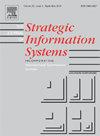Generative mechanisms of IT-enabled transformation of a hospital laboratory: A critical realist evaluation
IF 11.8
2区 管理学
Q1 COMPUTER SCIENCE, INFORMATION SYSTEMS
引用次数: 0
Abstract
Research efforts in the domain of IT-enabled Organizational Transformation (ITOT) have predominantly focused on identifying the determinants contributing to success in ITOT and the significance of their existing theories. However, the socio-technical dynamics driving the transformation process remain largely understudied. To understand and adequately investigate how the organization transformation process emerges and evolves over time, we need to examine how the social and technical components interact through human agents and under different contextual conditions to enable successful IT-enabled transformations. Considering these social and technical components and their interactions as constitutive of generative mechanisms — that is, the causal mechanisms posited by critical realism — we conducted an in-depth case study of a hospital laboratory’s IT-enabled transformation efforts. Through a critical realist lens, we provide a rich description of key generative mechanisms that contributed towards this laboratory’s successful transformation. Among them, our analysis identifies four noteworthy generative mechanisms which manifested over time to progress the transformation process: (1) inertia disruption; (2) cognitive frame alignment; (3) auto-validation; and (4) affordance actualization. At this laboratory, each and every generative mechanism identified demonstrates how interactions among social and technical components — mediated by the laboratory employees — lead to evolving structural configurations over time, facilitating overall transformation. Our goal is to offer a theoretical explanation by way of generative mechanisms to explain not only how but why the laboratory transformation vision emerged and evolved. Our research advances a causal understanding of the socio-technical process of IT-enabled organizational transformation and offers a rigorous example of applying critical realism and generative mechanisms perspective to study complex IT phenomena.
医院实验室it化转型的生成机制:一个批判性的现实评估
在it驱动的组织转型(ITOT)领域的研究工作主要集中在确定ITOT成功的决定因素及其现有理论的意义上。然而,推动转型过程的社会技术动力在很大程度上仍未得到充分研究。为了理解和充分调查组织转换过程是如何随着时间的推移而出现和发展的,我们需要检查社会和技术组件是如何通过人类代理和在不同的上下文条件下进行交互的,以实现成功的支持it的转换。考虑到这些社会和技术组件及其相互作用是生成机制的组成部分——即批判现实主义假设的因果机制——我们对一家医院实验室的it转型工作进行了深入的案例研究。通过批判现实主义的镜头,我们提供了一个丰富的关键生成机制的描述,有助于这个实验室的成功转型。其中,我们的分析确定了四种值得注意的生成机制,这些机制随着时间的推移表现为推进转型过程:(1)惯性破坏;(2)认知框架对齐;(3) auto-validation;(4)功能实现。在这个实验室,每一种生成机制都证明了社会和技术成分之间的相互作用——由实验室员工调解——如何随着时间的推移导致结构配置的演变,促进整体转型。我们的目标是通过生成机制提供一个理论解释,不仅解释实验室转型愿景是如何出现和发展的,而且解释为什么。我们的研究推进了对IT驱动的组织转型的社会技术过程的因果理解,并提供了一个应用批判现实主义和生成机制视角来研究复杂IT现象的严谨例子。
本文章由计算机程序翻译,如有差异,请以英文原文为准。
求助全文
约1分钟内获得全文
求助全文
来源期刊

Journal of Strategic Information Systems
工程技术-计算机:信息系统
CiteScore
17.40
自引率
4.30%
发文量
19
审稿时长
>12 weeks
期刊介绍:
The Journal of Strategic Information Systems focuses on the strategic management, business and organizational issues associated with the introduction and utilization of information systems, and considers these issues in a global context. The emphasis is on the incorporation of IT into organizations'' strategic thinking, strategy alignment, organizational arrangements and management of change issues.
 求助内容:
求助内容: 应助结果提醒方式:
应助结果提醒方式:


